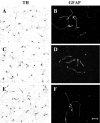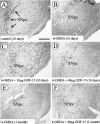Growth/differentiation factor-15/macrophage inhibitory cytokine-1 is a novel trophic factor for midbrain dopaminergic neurons in vivo
- PMID: 11102463
- PMCID: PMC6773071
- DOI: 10.1523/JNEUROSCI.20-23-08597.2000
Growth/differentiation factor-15/macrophage inhibitory cytokine-1 is a novel trophic factor for midbrain dopaminergic neurons in vivo
Abstract
Transforming growth factor-betas (TGF-betas) constitute an expanding family of multifunctional cytokines with prominent roles in development, cell proliferation, differentiation, and repair. We have cloned, expressed, and raised antibodies against a distant member of the TGF-betas, growth/differentiation factor-15 (GDF-15). GDF-15 is identical to macrophage inhibitory cytokine-1 (MIC-1). GDF-15/MIC-1 mRNA and protein are widely distributed in the developing and adult CNS and peripheral nervous systems, including choroid plexus and CSF. GDF-15/MIC-1 is a potent survival promoting and protective factor for cultured and iron-intoxicated dopaminergic (DAergic) neurons cultured from the embryonic rat midbrain floor. The trophic effect of GDF-15/MIC-1 was not accompanied by an increase in cell proliferation and astroglial maturation, suggesting that GDF-15/MIC-1 probably acts directly on neurons. GDF-15/MIC-1 also protects 6-hydroxydopamine (6-OHDA)-lesioned nigrostriatal DAergic neurons in vivo. Unilateral injections of GDF-15/MIC-1 into the medial forebrain bundle just above the substantia nigra (SN) and into the left ventricle (20 microgram each) immediately before a 6-OHDA injection (8 microgram) prevented 6-OHDA-induced rotational behavior and significantly reduced losses of DAergic neurons in the SN. This protection was evident for at least 1 month. Administration of 5 microgram of GDF-15/MIC-1 in the same paradigm also provided significant neuroprotection. GDF-15/MIC-1 also promoted the serotonergic phenotype of cultured raphe neurons but did not support survival of rat motoneurons. Thus, GDF-15/MIC-1 is a novel neurotrophic factor with prominent effects on DAergic and serotonergic neurons. GDF-15/MIC-1 may therefore have a potential for the treatment of Parkinson's disease and disorders of the serotonergic system.
Figures





Similar articles
-
Growth/differentiation factor-15 (GDF-15), a novel member of the TGF-beta superfamily, promotes survival of lesioned mesencephalic dopaminergic neurons in vitro and in vivo and is induced in neurons following cortical lesioning.J Neural Transm Suppl. 2003;(65):197-203. doi: 10.1007/978-3-7091-0643-3_12. J Neural Transm Suppl. 2003. PMID: 12946057 Review.
-
Growth/differentiation factor-15 deficiency compromises dopaminergic neuron survival and microglial response in the 6-hydroxydopamine mouse model of Parkinson's disease.Neurobiol Dis. 2016 Apr;88:1-15. doi: 10.1016/j.nbd.2015.12.016. Epub 2015 Dec 28. Neurobiol Dis. 2016. PMID: 26733415
-
Short communication: transforming growth factor-beta mediates the neurotrophic effect of fibroblast growth factor-2 on midbrain dopaminergic neurons.Eur J Neurosci. 1998 Aug;10(8):2746-50. Eur J Neurosci. 1998. PMID: 9767406
-
GDF-15/MIC-1 a novel member of the TGF-beta superfamily.J Neural Transm Suppl. 2000;(60):273-6. doi: 10.1007/978-3-7091-6301-6_18. J Neural Transm Suppl. 2000. PMID: 11205146 Review.
-
Trophic and protective effects of growth/differentiation factor 5, a member of the transforming growth factor-beta superfamily, on midbrain dopaminergic neurons.J Neurosci Res. 1995 Dec;42(5):724-32. doi: 10.1002/jnr.490420516. J Neurosci Res. 1995. PMID: 8600306
Cited by
-
Circulating Growth Differentiation Factor 15 Is Associated with Diabetic Neuropathy.J Clin Med. 2022 May 27;11(11):3033. doi: 10.3390/jcm11113033. J Clin Med. 2022. PMID: 35683420 Free PMC article.
-
Roles for the TGFβ superfamily in the development and survival of midbrain dopaminergic neurons.Mol Neurobiol. 2014 Oct;50(2):559-73. doi: 10.1007/s12035-014-8639-3. Epub 2014 Feb 7. Mol Neurobiol. 2014. PMID: 24504901 Review.
-
Elevated P75NTR expression causes death of engrailed-deficient midbrain dopaminergic neurons by Erk1/2 suppression.Neural Dev. 2009 Mar 16;4:11. doi: 10.1186/1749-8104-4-11. Neural Dev. 2009. PMID: 19291307 Free PMC article.
-
The relationship of serum macrophage inhibitory cytokine-1 levels with gray matter volumes in community-dwelling older individuals.PLoS One. 2015 Apr 13;10(4):e0123399. doi: 10.1371/journal.pone.0123399. eCollection 2015. PLoS One. 2015. PMID: 25867953 Free PMC article.
-
GDF-15 in Pulmonary and Critical Care Medicine.Am J Respir Cell Mol Biol. 2019 Jun;60(6):621-628. doi: 10.1165/rcmb.2018-0379TR. Am J Respir Cell Mol Biol. 2019. PMID: 30633545 Free PMC article.
References
-
- Aebischer P, Schluep M, Delon N, Joseph JM, Hirt L, Heyd B, Goddard M, Hammang JP, Zurn AD, Kato AC, Regli F, Baetge EE. Intrathecal delivery of CNTF using encapsulated genetically modified xenogeneic cells in amyotrophic lateral sclerosis patients. Nat Med. 1996;2:696–699. - PubMed
-
- Alexi T, Hefti F. Trophic actions of transforming growth factor alpha on mesencephalic neurons developing in culture. Neuroscience. 1993;55:903–918. - PubMed
-
- Behar T, McMorris FA, Novotny EA, Barker JL, Dubois-Dalc M. Growth and differentiation properties of O-2A progenitors purified from rat cerebral hemispheres. J Neurosci Res. 1988;21:168–180. - PubMed
-
- Bieger S, Unsicker K. Functions of fibroblast growth factors (FGFs) in the nervous system. In: Bell C, editor. Chemical factors in neuronal growth, degeneration and repair. Elsevier; Amsterdam: 1996. pp. 339–361.
-
- Bootcov MR, Bauskin AR, Valenzuela SM, Moore AG, Bansal M, He XY, Zhang HP, Donnellan M, Mahler S, Pryor K, Walsh BJ, Nicholson RC, Fairlie WD, Por SP, Robbins JM, Breit SN. Mic-1, a novel macrophage inhibitory cytokine, is a divergent member of the TGF-β superfamily. Proc Natl Acad Sci USA. 1997;94:11514–11519. - PMC - PubMed
Publication types
MeSH terms
Substances
LinkOut - more resources
Full Text Sources
Other Literature Sources
